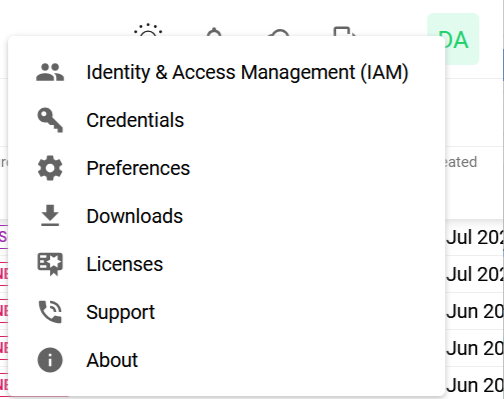SSH Credentials
Last Updated: 2025-09-18
Purpose
This article describes how to set up SSH Credentials in the Portal.
Introduction
SSH Credentials enable secure connections to assets for authenticated scanning by configuring SSH-based authentication details, such as usernames, passwords, and strongly recommended private keys, within the Portal’s Credentials view. This feature supports privilege escalation through commands like sudo, doas, or custom options, ensuring flexible and secure access to systems, particularly Linux, Unix, or Solaris environments. By setting up SSH Credentials, security teams can perform authenticated scans to identify vulnerabilities with elevated permissions, enhancing the accuracy of security assessments. The integration with private key encryption and passphrase protection strengthens data security, making it essential for organizations aiming to maintain robust access control and compliance during vulnerability management processes.
Adding SSH Credentials
Requirements
Although username+password only configurations are allowed, a private SSH-key is STRONGLY recommended for this operation.
Windows
To check if SSH is installed:
Open a command terminal and run the
sshcommand.
C:\Users\JohnDoe>sshIf SSH is installed, it will display some help text:
C:\Users\JohnDoe>ssh
usage: ssh [-46AaCfGgKkMNnqsTtVvXxYy] [-B bind_interface]
[-b bind_address] [-c cipher_spec] [-D [bind_address:]port]
[-E log_file] [-e escape_char] [-F configfile] [-I pkcs11]
[-i identity_file] [-J [user@]host[:port]] [-L address]
[-l login_name] [-m mac_spec] [-O ctl_cmd] [-o option] [-p port]
[-Q query_option] [-R address] [-S ctl_path] [-W host:port]
[-w local_tun[:remote_tun]] destination [command]
C:\Users\JohnDoe>Create the key by running the
ssh-keygencommand:
C:\Users\JohnDoe>ssh-keygen -t rsa -b 4096
Generating public/private rsa key pair.
Enter file in which to save the key (C:\Users\JohnDoe/.ssh/id_rsa):
Enter passphrase (empty for no passphrase):
Enter same passphrase again:
Your identification has been saved in C:\Users\JohnDoe/.ssh/id_rsa.
Your public key has been saved in C:\Users\JohnDoe/.ssh/id_rsa.pub.
The key fingerprint is:
SHA256:YSDOYF58kEbRekZhRrh2FxOIl/5cdPMgyrh/tAyOwFs azuread\johndoe@DESKTOP-AD5B8S3
The key's randomart image is:
+---[RSA 4096]----+
| o+X@o.. |
| .+o+X*.o |
| .o.O=++ . |
| .*=B= |
| .+E=o. |
| .o+ |
| . . . |
| . + . |
| ..+ |
+----[SHA256]-----+
C:\Users\JohnDoe>Unix
To generate a SSH-key:
Run the
ssh-keygencommand:
$ ssh-keygen -t rsa -b 4096
Generating public/private rsa key pair.
Enter file in which to save the key (/home/user/.ssh/id_rsa): /home/user/test
Enter passphrase (empty for no passphrase):
Enter same passphrase again:
Your identification has been saved in /home/user/test.
Your public key has been saved in /home/user/test.pub.
The key fingerprint is:
SHA256:YSDOYF58kEbRekZhRrh2FxOIl/5cdPMgyrh/tAyOwFs user@client.example.com
The key's randomart image is:
+---[RSA 4096]----+
| E+ . +.o |
| o = * B . |
| o = + o |
| o . o |
|. + + o S |
| o.o + . . . |
|ooo + . o o = |
|.+o. + + =.= . |
|o=. . o =+o.o |
+----[SHA256]-----+
$Adding Credentials
Log in to OUTSCAN. See the Logging in to the portal article on how to access the Portal.
In the Portal view, click the Account button in the upper right corner. Initials in the button may differ depending on the account name.

Select Credentials in the context menu.

Click the + Add credentials button to open the Add credentials form.

Setting up SSH Credentials
In the drop-down menu select SSH.
Enter a Role.
Enter a Username.
Enter a Password.
The password field can be used by both or either the authentication step or the substitute user command. In practice neither Password or Private key will be required to do anything, however, there are no such requirement asserted by the UI or API today.
Select Substitute user command: sudo, doas, sesu, dzdo, pfexec from the drop down menu, or provide a custom command on the line beneath.
The use of the following commands is to execute commands with a different user/privilege escalation.
Command | Description |
|---|---|
sudo | This command is found in most of the Linux based systems (or can be installed). Used to execute commands as a different user (other than the one used to log in). From the tools perspective, it uses root account to perform the commands. |
doas | It is an OpenBSD based command. 95% of its features are like sudo. https://man.openbsd.org/doas |
sesu | It is an IBM implementation of su. |
dzdo | Used in Linux/Unix (can be installed at will). An alternative to sudo. |
pfexec | Mostly used in Solaris. |
custom | It gives a flexibility to use a custom defined privilege escalation command. When this option is selected, a field labeled SSH custom user command is ungrayed for typing in the custom command. |
Click the blue Upload Private Key button.

This opens a file upload window.
Select a file. See Requirements section on how to create a private key in SSH.
Click Open button lower right corner to upload.
Add the passphrase to the private key.

This is required if you have uploaded a private key and that private key is encrypted with a passphrase.
Click blue Add button.

Related Articles
Copyright
© 2026 Outpost24® All rights reserved. This document may only be redistributed unedited and unaltered. This document may be cited and referenced only if clearly crediting Outpost24® and this document as the source. Any other reproduction and redistribution in print or electronically is strictly prohibited without explicit permission.
Trademark
Outpost24® and OUTSCAN™ are trademarks of Outpost24® and its affiliated companies. All other brand names, product names or trademarks belong to their respective owners.
